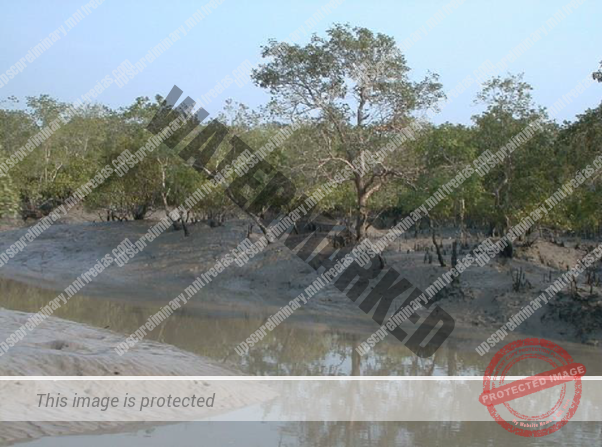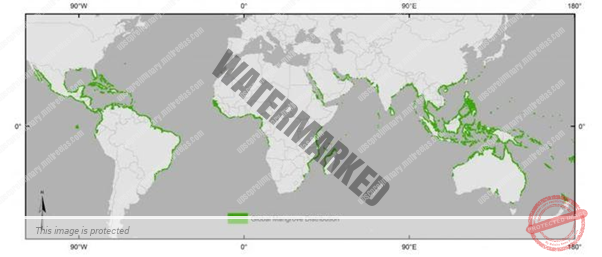- IDEAL CONDITIONS FOR CORAL GROWTH
- WHAT IS CORAL BLEACHING?
- CAUSES OF CORAL BLEACHING
- MANGROVE
- MANGROVES HAVE SEVERAL REQUIREMENTS TO DEVELOP
- THREATHS TO MANGROVE FORESTS AND THEIR HABITATS
UNIT 1 – ECOLOGY & ECOSYSTEM – PART 3
IDEAL CONDITIONS FOR CORAL GROWTH:
- STABLE CLIMATIC CONDITIONS:Corals are highly susceptible to quick changes. They grow in regions where climate is significantly stable for a long period of time.
- PERPETUALLY WARM WATERS: Corals thrive in tropical waters [30°N and 30°S latitudes, The temperature of water is around 20°C] where diurnal and annual temperature ranges are very narrow.
- SHALLOW WATER:Coral require fairly good amount of sunlight to survive. The ideal depths for coral growth are 45 m to 55 m below sea surface, where there is abundant sunlight available.
- CLEAR SALT WATER:Clear salt water is suitable for coral growth, while both fresh water and highly saline water are harmful.
- ABUNDANT PLANKTON:Adequate supply of oxygen and microscopic marine food, called plankton [phytoplankton], is essential for growth. As the plankton is more abundant on the seaward side, corals grow rapidly on the seaward side.
- LITTLE OR NO POLLUTION: Corals are highly fragile and are vulnerable to climate change and pollution and even a minute increase in marine pollution can be catastrophic.
WHAT IS CORAL BLEACHING?
The stunning colors in corals come from a marine alga called zooxanthellae, which live inside their tissues. This alga provides the corals with an easy food supply thanks to photosynthesis, which gives the corals energy, allowing them to grow and reproduce.
When corals get stressed, from things such as Heat or Pollution, they react by expelling these algae, leaving a ghostly, transparent skeleton behind. This is known as ‘coral bleaching’. Some corals can feed themselves, but without the zooxanthellae most corals starve.
CAUSES OF CORAL BLEACHING
- Rise in Sea Temperature:Most coral species live in waters close to the warmest temperature they can tolerate i.e., a slight increase in ocean temperature can harm corals. El Nino elevates the sea temperature and destroys coral reefs.
- Ocean Acidification:Due to rise in carbon dioxide levels, oceans absorb more carbon dioxide. This increases the acidity of ocean water and inhibits the corals ability to create calcareous skeletons, which is essential for their survival.
- Solar Radiation And Ultraviolet Radiation:Changes in tropical weather patterns result in less cloud cover and more radiations which induce coral bleaching.
- Chemical Pollution:Increased nutrient concentrations affect corals by promoting phytoplankton growth, which in turn supports increased numbers of organisms that compete with coral for space.
- Increased Sedimentation:Land clearing and coastal construction result in high rates of erosion and a higher density of suspended silt particles which can
- Smother Corals When Particles Settle Out (Sedimentation),
- Reducing Light Availability (Turbidity) and
- Potentially Reducing Coral Photosynthesis and Growth.
- Human Induced Threats:Over-fishing, pollution from agricultural and industrial runoff, coral mining, development of industrial areas near coral ecosystems also adversely impacts corals.
- Invasive Species: Lionfish are native to coral reefs in the tropical waters of the South Pacific and Indian Oceans. This is an invasive species that threatens the well-being of coral reefs and other marine ecosystems.
MANGROVE
Mangrove refers to an ecological group of halophytic plant species as well as to a variety of complex plant communities dominated by these species.
The mangrove ecosystems are found in the Inter-Tidal Zones of Sheltered Shores, Estuaries, Creeks, Backwaters, Lagoons, Marshes and Mudflats, along the tropical coastlines of Asia, Australia, and Americas.
The dominant salt-tolerant, sclerophyllous broadleaved trees form a unique ecosystem with associated plants, including epiphytic and Terrestrial Ferns, Orchids, Lichens, Non-Mangrove Halophytes, Sea Grasses and Seaweeds, And Fauna Such As Fish, Shrimp, Shellfish, Crabs, Lobsters, Reptiles And Birds.
These provide habitats and nutrients to a number of animals and Harbour several Endangered Species ranging from reptiles (e.g., Crocodiles, Iguanas and Snakes) and amphibians, to mammals (Tigers, Deer, Otters and Dolphins) and birds (Herons, Egrets, Pelicans and Eagles).
The tree trunks, leaves and roots provide habitats for diverse fauna. Many organisms’ colonies mangrove roots such as sponges, clams, algae, and oysters.
The coastal zone of India and that of Andaman and Nicobar Islands have the presence of extensive and diverse mangroves. These ecosystems are found along both the east and west coasts of India.
In India, important mangrove areas are in the Sundarbans, Bhitarkanika, Krishna and Godavari delta of Andhra Pradesh, Andaman and Nicobar Islands, Gulf of Kachchh, and the Pichavaram-Vedaranyam area of Tamil Nadu coast.
Breathing roots:
Underground tissue of any plant requires oxygen for respiration and in mangrove environment, oxygen in soil is very limited or nil. This necessitates mangrove root system to take up oxygen from the atmosphere.
For this purpose, mangrove species have specialized above ground roots called breathing roots or pneumatophores. In some species, these roots are pencil sized and peg like whereas in some other species they look like a knee.
These roots have numerous pores through which oxygen enters into the underground tissues. In some plants buttress roots function as breathing roots and also provide mechanical support to the tree.
Silt roots:
In some mangrove species, roots diverge from stems and branches and penetrate the soil some distance away from the main stem as in the case of banyan trees.
Because of their appearance and because they provide the main physical support to these they are called as stilt roots. These roots also have many pores through which atmospheric oxygen enters into the roots.
Vivipary:
Saline water, unconsolidated saline soil with little or no oxygen is not a conducive environment for seeds to germinate and establish. To overcome this, mangrove species have unique way of reproduction, which is generally known as vivipary.
The parent tree supplies water and necessary nutrients. They are buoyant and float in the water for some time before rooting themselves on suitable soil.
MANGROVES HAVE SEVERAL REQUIREMENTS TO DEVELOP:
- They need average temperatures of the coldest month higher than 20°C. The seasonal temperature range should not exceed 5°C. They can tolerate temperatures of 5°C, but the development will be affected. They are not resistant to freezing.
- In general, they need a fine-grained substrate. But there could be some exceptions. This is the case in Papua New Guinea and Kenya, where the mangroves grow on corals.
- They need salt water. They are facultative halophytes.
- They need a large tidal range. This causes limited erosion and deposition of sediments.
THREATS TO MANGROVE FORESTS AND THEIR HABITATS
- Clearing:
Mangrove forests have often been seen as unproductive and smelly, and so cleared to make room for agricultural land, human settlements, and infrastructure (such as harbours), and industrial areas. More recently, clearing for tourist developments, shrimp aquaculture, and salt farms has also taken place. This clearing is a major factor behind mangrove loss around the word.
- Overharvesting:
Mangrove trees are used for firewood, construction wood, wood chip and pulp production, charcoal production, and animal fodder. While harvesting has taken place for centuries, in some parts of the world it is no longer sustainable, threatening the future of the forests.
- Pollution:Fertilizers, pesticides, and other toxic man-made chemicals carried by river systems from sources upstream can kill animals living in mangrove forests, while oil pollution can smother mangrove roots and suffocate the trees.
- Climate change: Mangrove forests require stable sea levels for long-term survival. They are therefore extremely sensitive to current rising sea levels caused by global warming and climate change.


